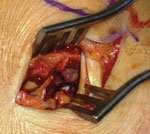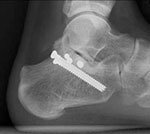Study finds limited sinus tarsi approach superior to extensile lateral for calcaneus fractures
KEYSTONE, Colo. – Although a limited sinus tarsi approach for calcaneal fracture fixation showed fewer wound healing problems and postoperative infections than the standard extensile lateral approach, a recently presented study showed that both methods had similar radiographic and clinical outcomes.
“There is controversy regarding whether we should really abandon the classical open techniques and this study does not dispel that controversy, but it does provide data to show that further investigation is both ethical and appropriate,” Wade R. Smith, MD, senior author of the study, told Orthopedics Today.
His colleague, Patrick J. Maloney, MD, presented the results of the retrospective study led by principal investigator Gerard J. Cush, MD, at the 2011 Annual Meeting of the American Orthopaedic Foot and Ankle Society.
The investigators compared 26 patients who underwent the sinus tarsi approach with a group of 52 patients who underwent the extensile lateral approach for calcaneus fractures. Age, gender ratio, fracture classification distribution and injury mechanism were similar between the groups.
|
|
|
Images: Maloney PJ |
The team analyzed outcomes using AOFAS hindfoot scores and angles of Bohler and Gissane on plain radiographs. Average follow-up was 24 months for extensile lateral group and 15 months for sinus tarsi group.
Postoperative AOFAS hindfoot scores and angles of Bohler and Gissane were similar between the cohorts, but the sinus tarsi group demonstrated fewer complications and wound healing problems. Complications in the extensile lateral group included wound necrosis, deep infection, sural neuritis, chronic serious drainage, superficial infection and re-operations for arthrodesis or wound healing problems.
“The sinus tarsi group had lower rates of wound edge necrosis, deep infection and chronic serous drainage,” Maloney said. “They had equivalent rates of superficial infection and sural neuritis compared to the extensile group.”
The researchers plan to conduct further prospective studies to evaluate joint mechanics, prevention of osteoarthritis and preservation of gait with the sinus tarsi approach. They also recommend paying close attention to location of the sural nerve for either approach, according to the study abstract. – by Renee Blisard
Reference:
- Maloney PJ, Cush GJ, Smith WR, Widmaier JC, et al. Calcaneal fixation: extensile lateral versus sinus tarsi mini-incision approach – early outcome evaluation. Presented at the 2011 Annual Meeting of the American Orthopaedic Foot and Ankle Society. July 13-15. Keystone, Colo.

- Patrick J. Maloney, MD, can be reached at Geisinger Medical Center, 100 N. Academy Ave., Danville, PA 17822; 800-275-6401; email: pjmaloney@geisinger.edu.
- Wade R. Smith, MD, can be reached at Swedish Hospital, 701 E. Hampden Ave., Ste. 515, Englewood, CO 80113; 303-209-2503; email: wadesmith2@gmail.com.
- Disclosures: Maloney has no relevant financial disclosures. Smith is a consultant to Synthes and Medtronic.
The approach to treating calcaneal fractures has changed over time. Early on, these fractures were treated conservatively with a cast. Improved surgical techniques and understanding of proper soft-tissue handling led to open reduction and internal fixation through an extensile lateral approach. Unfortunately, these procedures are fraught with potential complications; most notably delayed wound healing and infections. To potentially reduce complications, an attempt has been made in recent years to develop alternative approaches to fixation of calcaneal fractures.
This study compared a group of calcaneal fractures treated with an extended lateral approach to a similar group treated via an alternative sinus tarsi incision approach. I was surprised by their high rate of severe complications in the extended lateral approach. A 17% incidence of deep infections, 17% incidence of wound necrosis and 17% incidence of sural neuritis is higher than one would expect to see with this method. I agree with their findings of lower complication rates utilizing a sinus tarsi approach and would encourage its use in the appropriate fracture pattern. Their population did not include the more severe calcaneal fractures (Sanders type 4), which I believe are more difficult to reduce utilizing a sinus tarsi approach. Those comminuted fractures, I feel, warrant the extended lateral approach in order to better visualize and reduce the fragments.
— Steven Neufeld, MD
The Orthopaedic Foot
and Ankle Center
Washington, DC
Disclosure: Neufeld has no
relevant financial disclosures.











